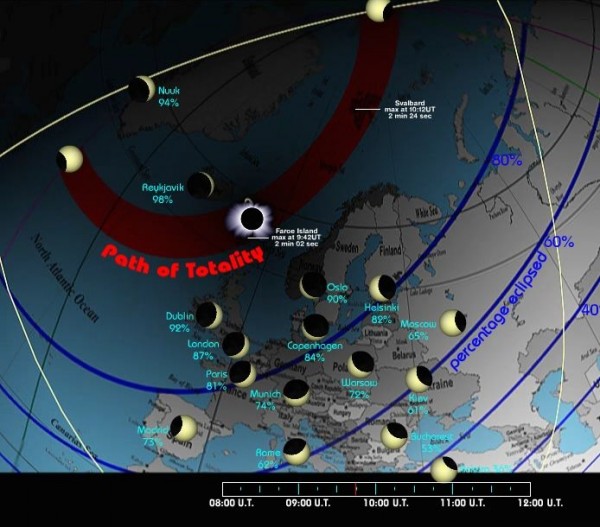Latest topics
Supermoon Total Eclipse Of Equinox Sun On March 20
3 posters
Page 1 of 1
 Supermoon Total Eclipse Of Equinox Sun On March 20
Supermoon Total Eclipse Of Equinox Sun On March 20
Supermoon Total Eclipse Of Equinox Sun On March 20
Saturday, 14 March 2015

On March 20 – same date as the 2015 March equinox – the moon turns new only 14 hours after reaching lunar perigee – moon’s closest point to Earth in its orbit. Thus this moon is a supermoon – at the new phase – not visible in our sky, but having a larger-than-average effect on Earth’s oceans. Plus this new supermoon swings right in front of the equinox sun on March 20, so that the moon’s shadow falls on parts of Earth. Follow the links below to learn more.
 Who will see the March 20 eclipse?
Who will see the March 20 eclipse?
How to watch an eclipse safely
March 20 total eclipse times from land
March 20 partial eclipse times
Still not sure when to watch? Try these links
What causes a solar eclipse?
 The solar eclipse of March 20, 2015. Map by Larry Koehn. See it larger, in animated form, at his wonderful website shadowandsubstance.com.Who will see the March 20 eclipse? Note on the worldwide map above that the path of totality (in blue) passes mainly over the frigid waters of North Atlantic Ocean. In other words, only those along that path – at high northern latitudes, near Greenland and Iceland – will see the total eclipse. The path of totality starts at sunrise to the south of Greenland, circles to the east of Greenland and Iceland at midday, and ends to the north of Greenland at sunset. The best spots to watch this total solar eclipse from land are the Faroe Islands and the Svalbard archipelago, which reside right on the semi-circle path of totality. Eclipse times for total eclipse below.
The solar eclipse of March 20, 2015. Map by Larry Koehn. See it larger, in animated form, at his wonderful website shadowandsubstance.com.Who will see the March 20 eclipse? Note on the worldwide map above that the path of totality (in blue) passes mainly over the frigid waters of North Atlantic Ocean. In other words, only those along that path – at high northern latitudes, near Greenland and Iceland – will see the total eclipse. The path of totality starts at sunrise to the south of Greenland, circles to the east of Greenland and Iceland at midday, and ends to the north of Greenland at sunset. The best spots to watch this total solar eclipse from land are the Faroe Islands and the Svalbard archipelago, which reside right on the semi-circle path of totality. Eclipse times for total eclipse below.
A much larger swath of the world gets to see varying degrees of a partial solar eclipse (Greenland, Iceland, Europe, northern Africa, the Middle East and northwestern Asia). Eclipse times for partial eclipse below.

The photo above shows one method for safely watching the partial phases of a solar eclipse: the projection method.
You can also view an eclipse safely through special eclipse glasses. Purchase eclipse glasses from the EarthSky store.
Click here for more details on how to watch a solar eclipse safely.
March 20, 2015 total eclipse times from land
Tórshavn, Faroe Islands
Partial solar eclipse begins: 8:39 a.m. Western European Time (WET)
Total solar eclipse begins: 9:41 a.m. WET
Maximum eclipse: 9:42 a.m. WET
Total solar eclipse ends: 9:43 a.m. WET
Partial solar eclipse ends: 10:48 a.m. WET
Longyearbyen, Svalbard
Partial solar eclipse begins: 10:12 a.m. Central European Time (CET)
Total solar eclipse begins: 11:11 a.m. CET
Maximum eclipse: 11:12 a.m. CET
Total solar eclipse ends: 11:13 a.m. CET
Partial solar eclipse ends: 12:12 a.m. CET
Source: TimeandDate.com

Solar eclipse begins: 8:38 a.m. Greenwich Mean Time (GMT)
Greatest eclipse: 9:37 a.m. GMT
Solar eclipse ends: 10:39 a.m. GMT
Maximum obscuration of solar disk: 98%
London, England
Solar eclipse begins: 8:25 a.m. Greenwich Mean Time (GMT)
Greatest eclipse: 9:31 a.m. GMT
Solar eclipse ends: 10:41 a.m. GMT
Maximum obscuration of solar disk: 84%
Algiers, Algeria
Solar eclipse begins: 9:06 a.m. Central European Time (CET)
Greatest eclipse: 10:11 a.m. CET
Solar eclipse ends: 11:20 a.m. CET
Maximum obscuration of solar disk: 53%
Istanbul, Turkey
Solar eclipse begins: 10:53 p.m. Eastern European Time (EET)
Greatest eclipse: 11:57 a.m. EET
Solar eclipse ends: 1:02 p.m. EET
Maximum obscuration of solar disk: 32%
Moscow, Russia
Solar eclipse begins: 12:13 p.m. Moscow Standard Time (MST)
Greatest eclipse: 1:20 p.m. MST
Solar eclipse ends: 2:27 p.m. MST
Maximum obscuration of solar disk: 58%
TimeandDate.com – gives eclipse times in local time
HM Nautical Almanac – eclipse animations for 534 localities
Interactive Google map – information is just a click away

The plane of the moon’s orbit around Earth is inclined at 5o to the plane of the Earth’s orbit around the sun. For half the month, the moon orbits Earth to the north of the ecliptic (Earth’s orbital plane); and for the other half of the month, the moon orbits Earth to the south of the ecliptic (Earth’s orbital plane). Twice a month, however, the moon crosses the Earth’s orbital plane at points called nodes. If the moon is traveling from north to south, it’s called a descending node, and when it’s going from south to north, it’s called an ascending node.
When a new moon happens while the moon is appreciably close to one of its nodes, a solar eclipse is not only possible – but inevitable. It’s not a perfect alignment, though, as the moon reaches its descending node about 17 hours after the moon turns new. However, the new moon happens close enough to its node for the moon’s dark umbral shadow to clip the northern reaches of the globe and for a total solar eclipse to take place at along a semi-circle path at far-northerly latitudes.
Want more? Try this NASA video:

VIEW: What's Up for March 2015
Read more: Earth Sky Org
Thanks to: http://www.earth-heal.com
Posted at: http://www.oom2.com
Saturday, 14 March 2015

Eclipse photo via NASA
By Bruce McClureOn March 20 – same date as the 2015 March equinox – the moon turns new only 14 hours after reaching lunar perigee – moon’s closest point to Earth in its orbit. Thus this moon is a supermoon – at the new phase – not visible in our sky, but having a larger-than-average effect on Earth’s oceans. Plus this new supermoon swings right in front of the equinox sun on March 20, so that the moon’s shadow falls on parts of Earth. Follow the links below to learn more.

How to watch an eclipse safely
March 20 total eclipse times from land
March 20 partial eclipse times
Still not sure when to watch? Try these links
What causes a solar eclipse?
How often does a solar eclipse happen on the March equinox?
 The solar eclipse of March 20, 2015. Map by Larry Koehn. See it larger, in animated form, at his wonderful website shadowandsubstance.com.
The solar eclipse of March 20, 2015. Map by Larry Koehn. See it larger, in animated form, at his wonderful website shadowandsubstance.com.A much larger swath of the world gets to see varying degrees of a partial solar eclipse (Greenland, Iceland, Europe, northern Africa, the Middle East and northwestern Asia). Eclipse times for partial eclipse below.

Safely watching a solar eclipse via the projection method. Photo by Flickr user David.
How to watch an eclipse safely. Remember to use proper eye protection if you want to observe this eclipse!The photo above shows one method for safely watching the partial phases of a solar eclipse: the projection method.
You can also view an eclipse safely through special eclipse glasses. Purchase eclipse glasses from the EarthSky store.
Click here for more details on how to watch a solar eclipse safely.
March 20, 2015 total eclipse times from land
Tórshavn, Faroe Islands
Partial solar eclipse begins: 8:39 a.m. Western European Time (WET)
Total solar eclipse begins: 9:41 a.m. WET
Maximum eclipse: 9:42 a.m. WET
Total solar eclipse ends: 9:43 a.m. WET
Partial solar eclipse ends: 10:48 a.m. WET
Longyearbyen, Svalbard
Partial solar eclipse begins: 10:12 a.m. Central European Time (CET)
Total solar eclipse begins: 11:11 a.m. CET
Maximum eclipse: 11:12 a.m. CET
Total solar eclipse ends: 11:13 a.m. CET
Partial solar eclipse ends: 12:12 a.m. CET
Source: TimeandDate.com

Partial eclipses are very beautiful, too. During the May 2012 eclipse, as the moon nearly blotted out the sun, many saw dancing illuminated crescents like these, created when the leaves of trees and bushes acted as pinhole cameras and projected the eclipsed sun’s image onto cars and buildings. This photo from Chris Walker in Dayton, Nevada.
March 20, 2015 partial eclipse times
Reykjavik, IcelandSolar eclipse begins: 8:38 a.m. Greenwich Mean Time (GMT)
Greatest eclipse: 9:37 a.m. GMT
Solar eclipse ends: 10:39 a.m. GMT
Maximum obscuration of solar disk: 98%
London, England
Solar eclipse begins: 8:25 a.m. Greenwich Mean Time (GMT)
Greatest eclipse: 9:31 a.m. GMT
Solar eclipse ends: 10:41 a.m. GMT
Maximum obscuration of solar disk: 84%
Algiers, Algeria
Solar eclipse begins: 9:06 a.m. Central European Time (CET)
Greatest eclipse: 10:11 a.m. CET
Solar eclipse ends: 11:20 a.m. CET
Maximum obscuration of solar disk: 53%
Istanbul, Turkey
Solar eclipse begins: 10:53 p.m. Eastern European Time (EET)
Greatest eclipse: 11:57 a.m. EET
Solar eclipse ends: 1:02 p.m. EET
Maximum obscuration of solar disk: 32%
Moscow, Russia
Solar eclipse begins: 12:13 p.m. Moscow Standard Time (MST)
Greatest eclipse: 1:20 p.m. MST
Solar eclipse ends: 2:27 p.m. MST
Maximum obscuration of solar disk: 58%
Still not sure when to watch? Try these links
You can obtain specific information on the March 20 eclipse in your part of the world at the sites listed below. Be sure to watch whether the times are given in Universal Time, meaning you must convert Universal Time into your local time.TimeandDate.com – gives eclipse times in local time
HM Nautical Almanac – eclipse animations for 534 localities
Interactive Google map – information is just a click away
Solar eclipse computer – courtesy of the US Naval observatory

When the new moon closely aligns with one of its nodes, the moon’s dark umbral shadow falls on Earth, presenting a total eclipse of the sun.
What causes a solar eclipse?
A solar eclipse happens whenever the new moon passes in front of the sun, and the moon’s shadow falls on our planet. A solar eclipse is only possible at new moon because that’s the only time whereby the moon to go in front of the sun, as seen from Earth. Most of the time, however, the new moon either swings north or south of the solar disk, so no eclipse of the sun takes place.The plane of the moon’s orbit around Earth is inclined at 5o to the plane of the Earth’s orbit around the sun. For half the month, the moon orbits Earth to the north of the ecliptic (Earth’s orbital plane); and for the other half of the month, the moon orbits Earth to the south of the ecliptic (Earth’s orbital plane). Twice a month, however, the moon crosses the Earth’s orbital plane at points called nodes. If the moon is traveling from north to south, it’s called a descending node, and when it’s going from south to north, it’s called an ascending node.
When a new moon happens while the moon is appreciably close to one of its nodes, a solar eclipse is not only possible – but inevitable. It’s not a perfect alignment, though, as the moon reaches its descending node about 17 hours after the moon turns new. However, the new moon happens close enough to its node for the moon’s dark umbral shadow to clip the northern reaches of the globe and for a total solar eclipse to take place at along a semi-circle path at far-northerly latitudes.
Want more? Try this NASA video:

VIEW: What's Up for March 2015
Read more: Earth Sky Org
Thanks to: http://www.earth-heal.com
Posted at: http://www.oom2.com

Purpleskyz- Admin

- Posts : 5765
Join date : 2011-08-16
Location : Woodstock Nation
 Re: Supermoon Total Eclipse Of Equinox Sun On March 20
Re: Supermoon Total Eclipse Of Equinox Sun On March 20
It's happening tomorrow here and I can't wait. I love the lunar eclipses, something really creepy about them and the super moon also, wow how cool!

alleyrose- Super Moderator

- Posts : 2851
Join date : 2011-08-24
Location : Australia
 Re: Supermoon Total Eclipse Of Equinox Sun On March 20
Re: Supermoon Total Eclipse Of Equinox Sun On March 20
You can also watch the eclipse with lightshielded welder's cutting glasses, or strong sunglasses- I've seen a few of the eclipses, without them- They are bright, but will not hurt your eyes for a few seconds- That is an old wive's tale-

Terbo56- VIP Member

- Posts : 13675
Join date : 2011-06-18
Age : 68
Location : Central Florida-

Purpleskyz- Admin

- Posts : 5765
Join date : 2011-08-16
Location : Woodstock Nation
 Re: Supermoon Total Eclipse Of Equinox Sun On March 20
Re: Supermoon Total Eclipse Of Equinox Sun On March 20
Yep, just like that! Gorgeous!!

Terbo56- VIP Member

- Posts : 13675
Join date : 2011-06-18
Age : 68
Location : Central Florida-
 Re: Supermoon Total Eclipse Of Equinox Sun On March 20
Re: Supermoon Total Eclipse Of Equinox Sun On March 20
I cant wait, we will eat dinner under the super moon!

alleyrose- Super Moderator

- Posts : 2851
Join date : 2011-08-24
Location : Australia
 Re: Supermoon Total Eclipse Of Equinox Sun On March 20
Re: Supermoon Total Eclipse Of Equinox Sun On March 20
Have candles as you won't be seeing the moon that night. New moon new beginnings..

Purpleskyz- Admin

- Posts : 5765
Join date : 2011-08-16
Location : Woodstock Nation

Purpleskyz- Admin

- Posts : 5765
Join date : 2011-08-16
Location : Woodstock Nation
Page 1 of 1
Permissions in this forum:
You cannot reply to topics in this forum

» Iraqi Dinar (IQD)
» The Iraqi Dinar Revaluation Scam: False Hope, Financial Deception
» Yes, the Iraqi Dinar is a SCAM: Responding to Marcus Williams' Comments on my Investment Scam Video
» AMERICA’S COLOR REVOLUTION — Brought To You By The U.S. Intelligence Community & Coming To A City Near You
» Go Russia
» I am too pretty for math, but....
» Interesting article
» Phony Tony: New Platform, same old song and dance
» The Craziness of Scam by "Tony TNT Renfrow" and the Iraqi Dinar Currency Scam
» Even conspiratorial currency speculators aren’t buying a Russian ruble revalue - It’s not the next the Iraqi dinar
» The Fundamentals of Finance and Pimpy Live
» Carnival Rides
» Go Russia
» Textbook Tony
» The Rockefellers and the controllers are freaking out right about now
» Phony Tony sez: Full Steam Ahead!
» Dave Schmidt - Zim Notes for Purchase (NOT PHYSICAL NOTES)
» Russia aren't taking any prisoners
» Deadly stampede could affect Iraq’s World Cup hopes 1/19/23